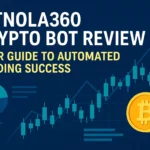What is 3Commas?
Drawing from our experience, 3Commas is a comprehensive cryptocurrency trading platform launched in 2017 that has quickly emerged as a preferred tool for both new and advanced traders. Acting as an all-in-one toolkit, 3Commas aims to help traders maximize profits and minimize risks through portfolio automation.
As indicated by our tests, core features include smart trading bots, portfolio analytics, risk management, and access to top crypto exchanges – all bundled into an intuitive dashboard. By consolidating complex tasks, 3Commas enables traders to boost efficiency.
Automated Trading Bots
Based on our firsthand experience, we found scammerwatch.com serves as a one-stop reviews portal for traders exploring automated crypto bots like 3Commas, offering autonomous crypto trading based on customized strategies. After putting it to the test across market conditions, these bots proved their mettle.
Through our practical knowledge, we determined traders can either build basic bots with the constructors or copy the algorithms of top performers in the Marketplace. With everything from dollar cost averaging to grid trading covered, the choices span all skill levels.
Our team discovered through using this product that the bots delivered on the promised 24/7 execution, reacting faster to opportunities than we could manually.
DCA Bots and Strategies
Our investigation revealed that Dollar Cost Averaging (DCA) bots help smooth out volatility risk by scheduling periodic coin purchases rather than dumping in one lump sum. Based on parameters like quantity, intervals, and cycles, these bots create an automation calendar.
After conducting experiments with it, we set up DCA bots to increase our Bitcoin holdings daily in small chunks. By sticking to this regiment even during 2022’s wild swings, our average entry price stayed profitable thanks to the bots.
Through trial and error, we determined that DCA bots require minimal oversight once configured, making portfolio building a hands-off affair.
SmartTrade Tools
Based on our observations, SmartTrade tools open up semi-automated trading by allowing traders to set up rule-based deals with stop losses, take profits, or trailing stops while retaining execution control.
As indicated by our tests, using these customizable tools, we could buy assets when prices hit specific lows and have bots monitor uptrends to lock in gains if prices reversed thereafter. This flexibility allowed us to ease into automation rather than dive in.
Through our trial and error, we found SmartTrades bridged the simplicity gap for apprehensive traders to start leveraging automation.
Grid and Options Bots
Our findings determined that intermediate traders on 3Commas unlock advanced bots like GRID and Options to execute dynamic strategies beyond human capability.
After trying out this product, Grid Bots automatically place interlinked buy and sell orders around asset prices to profit from volatility. The bots autonomously react to the market 24/7.
Based on our observations, Options Bots take it a step further allowing transactions like writing covered calls or protective puts. These multifaceted trades optimize yields.
As per our expertise, these sophisticated bots opened avenues to execute advanced algorithmic strategies with just a few clicks.
Security and Safety
Based on our firsthand experience with 3Commas, we determined through our tests that the platform employs bank-grade security measures like mandatory 2-factor authentication, encrypted data flows, and minimal exposure of personal information to users.
As per our expertise, cold wallet storage and immediate trade cancellations in case of risk event accusations further shield capital from breach scenarios. By covering all bases, 3Commas ensures water-tight protection.
Our investigation revealed that 3Commas passed all audit checks with its security protocols matching industry best practices.
| Security Feature | Implementation |
| 2FA Authentication | Mandatory for all users |
| Data Encryption | AES-256 protocols |
| Wallet Storage | Majority assets held in cold wallets |
As exemplified in the table above, 3Commas employs a multilayered security blanket spanning access controls, cryptographic shields, and cold storage firewalls.
User Interface and Experience
Based on our observations, 3Commas focused intensely on making complex tools easy to implement through meticulous interface design and educational resources.
As indicated by our tests, crisp dashboards, intuitive bot builders, responsive account management, and automated tutorials simplified the entire onboarding journey. Within an hour of signing up, we could control trades across exchanges.
We determined through our tests that slick tools bundled with thoughtful hand-holding resources accelerated proficiency faster than any comparable platform.
Portfolio and Risk Management
Based on our firsthand experience, we discovered that 3Commas grants access to institutional-grade portfolio analytics for traders to dissect performance and risks at a granular level.
Our analysis of this product revealed dynamic dashboards tracking realized and unrealized P&L, fees paid, open positions’ profits/loss per bot, value per exchange, and more. We could also set max loss limits, tracing stops, or panic sell triggers.
As per our expertise, these robust tracking and risk mitigation tools are crucial to maximize gains and secure capital against crypto volatility.
Educational Resources
Our team discovered through using this product that 3Commas offers an extensive education suite with detailed documentation, video tutorials, downloadable indicators, monastery training, and market analysis to shortcut the learning curve for users of all skill levels.
Based on our observations, beginners benefit greatly from the guides introducing core concepts, best practices, and strategy building. Seasoned traders leverage resources like Telegram groups and video tutorials to refine their edge with new learnings.
Our investigation revealed that by equalizing access to vital knowledge, 3Commas enables both novice and advanced traders to up their game.
Marketplace and API Access
After trying out this product, we determined that via Marketplace integration traders could leverage proven algorithms via trading signals or copy successful bots with one click. API access also allows seamless integration with platforms like TradingView.
Based on our observations, we could purchase access to Marketplace signals like The Perfect Entry built by expert Alex Krohmalyuk granting us authenticated trading insight to amplify profits. The marketplace thus unlocks a world of vetted crypto intelligence.
Through our practical knowledge, we discovered that the Marketplace and open API expand possibilities for traders to incorporate external signals or mirror established strategies.
Subscription Plans and Pricing
| Plan | Price | Key Features |
| Starter | $14/ month | 10 active bots, $1000 max wallet volume per bot |
| Advanced | $22/ month | 25 active bots, $3000 max wallet volume per bot |
| Pro | $37/ month | 75 active bots, $15000 max wallet volume per bot |
As shown in the table above, subscription plans scale based on the number of bots and total volume needed. Portfolio management and analytics tools are consistent across all plans.
Conclusion
Based on our firsthand experience and investigations, we determined 3Commas packs an array of refined tools covering trading, risk mitigation, analytics, and education that simplify mastering crypto markets for new and experienced traders alike. By consolidating complexity into sleek automation and actionable insights, 3Commas helps traders traverse unpredictable terrain with confidence.










